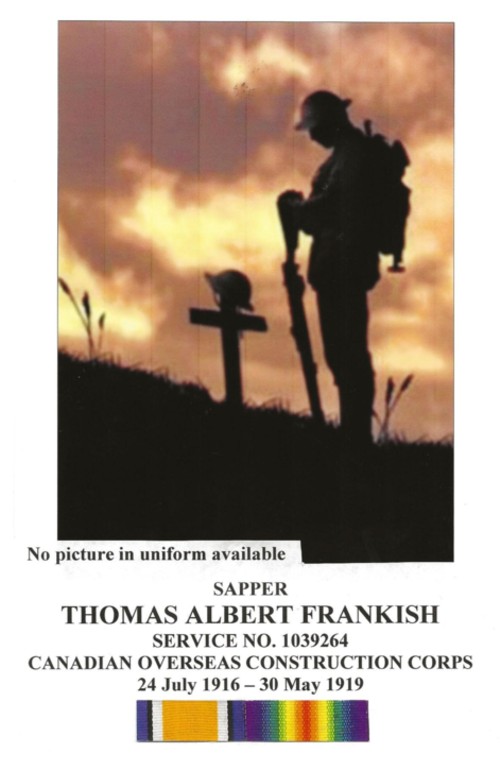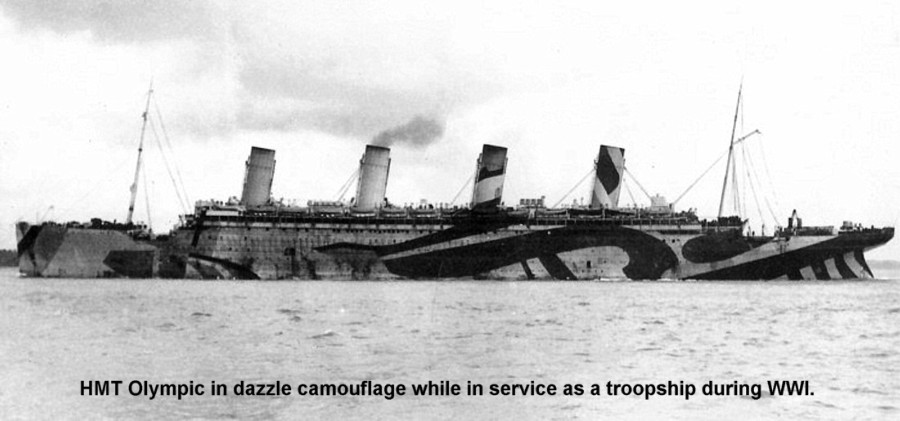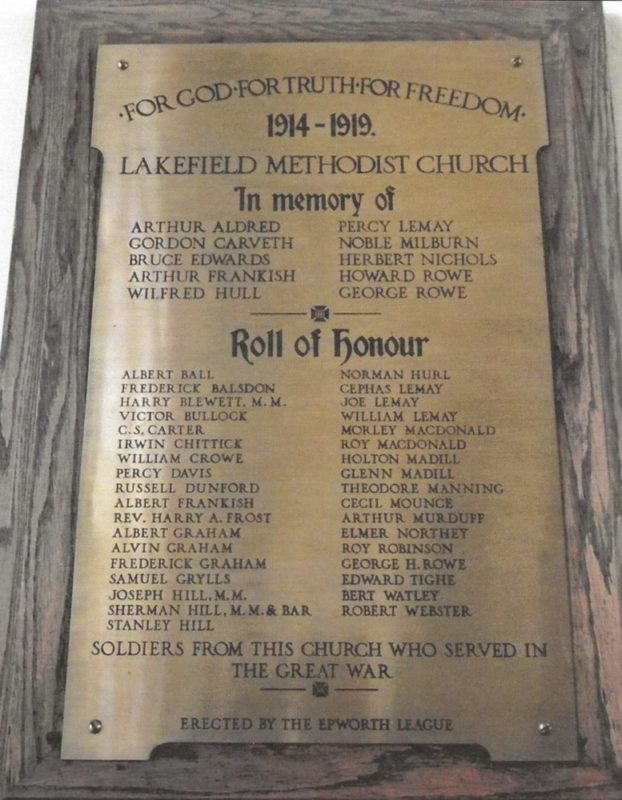
MILITARY HISTORY
Sapper Thomas Albert Frankish – 1039264 – Active Service (World War I)
On July 24th, 1916 Thomas Albert Frankish completed the Attestation Paper for the Canadian Expeditionary Force (CEF), at No. 13th, District Depot, in Calgary, Alberta. He was 35 years, and 6 months old, when as a single man, he enlisted for the duration of the War. Thomas Frankish indicated that he was born in Peterborough County, Ontario and gave his birth date as March 17th, 1880. The Attestation Paper does not indicate where he was educated or to what level. He listed Room 3, Carson Block, Calgary, Alberta as his current address. He indicated that he had no previous Military experience. As far as his Trade or Calling, he lists ”Locomotive Engineer”. Frankish was 5′ 8” tall, and had a 40” chest (expanded). He had a dark complexion, light brown eyes, and dark hair. His medical examination took place at Calgary, Alberta, on July 20th, 1916. He had no medical issues or physical limitations, and as such he was deemed fit (Category A), for Overseas duty with the Canadian Expeditionary Force. His next-of-kin was listed as his sister, Miss Lily Frankish of Lakefield, Ontario. Thomas Frankish signed the Oath and Certificate of Attestation on July 24th, 1916 in Calgary, Alberta. The Certificate of Magistrate was signed by the Justice on July 24th, 1916 also in Calgary. Thomas Albert Frankish taken-on-strength as a ”Sapper” with the 239th Canadian Overseas Railway Construction Corps CEF and was assigned Regimental Service Number 1039264.
The Certificate of Officer Commanding Unit was signed September 5th, 1916.
A Sapper with the Railway Construction Corps was the equivalent of a Private with the Infantry.
Some background information on the evolution of the Canadian Railway Construction Corps.
By mid 1915 the Allied War effort was proving that the use of roads, and animals, alone, were insufficient to move the required materials to the front, and sustain the needs of the Units; and that a greater emphasis would have to be placed on the existing railway network in France.
Based on its relevant experience of building railways across difficult terrain, and in all types of challenging weather, Canada was asked to supply two Railway Construction Companies. In 1915 500 men from Canadian Pacific Railway personnel were selected, and formed the Canadian Overseas Railway Construction Corps (COCC), arriving in France, August 1915. In the spring of 1916 Canada was requested to supply another 1000 men, to serve as Railway Troops.
The 239th Battalion Canadian Overseas Railway Construction Corps CEF was organized May 16th, 1916 under the command of Lieutenant Colonel J.W. Stewart.
On December 11th, 1916 prior to leaving Canada, Sapper Thomas Albert Frankish filled out the standard CEF Form of Will, bequeathing all his personal estate, and pay to his next-of-kin Miss Lily Frankish of Lakefield, Ontario.
The Military File indicates that Sapper Frankish embarked from Halifax, Nova Scotia aboard the SS Olympic, on December 15th, 1916 with the 239th Battalion (COCC), arriving at Liverpool on December 26th, 1916.

On February 3rd, 1917 the 239th Battalion (COCC) was re-designated the 3rd Battalion Canadian Railway Troops (CRT), under the command of Major J.R. McLean.
The arrival in France of three Battalions of Canadian Railway Troops – January, February and March 1917 were just-in-time to prove their worth. During the German retreat from the area of the Somme, in February – March, 1917 the three Battalions, in spite of obstacles, difficulties imposed by atrocious weather, and the thoroughness of the destruction left by the enemy in the wake of its retreat, the Battalions were able to push forward railway lines with surprising quickness.
April 9th, 1917 when the Battle of Arras took place, and the Canadians attacked Vimy Ridge, the terrible weather had turned the entire battle area into a quagmire. In spite of these conditions, the Canadian Railway Troops had laid new lines to within a short distance of the front line. As the Infantry advanced, so did the railway lines. Within a week of the start of this offensive, railway lines were to the very brow of Vimy Ridge. Men and materials were carried forward, and casualties were carried back.
Over the next year and one half, the Allies would make extensive use of the ever expanding Railway network; carrying men, ammunition, artillery guns, horses, and tanks, all across Belgium and France. Infantry War Diaries often referred to the Units ”entraining”, and being transported across long distances in ”re-positioning” moves.
The 3rd Battalion Canadian Railway Troops War Diary for the month of March, 1917 indicates the following:
At the beginning of the month, the 3rd Battalion was stationed at Purfleet, England which was the staging area for all Canadian Railway Troops.
March 7th, orders were received for 17 officers, and 277 others ranks to proceed overseas on the 10th. On the 8th, 17 officers, and 462 other ranks were ordered to proceed overseas on the 11th. The men paraded to the Purfleet Rifle Range, where they entrained to Folkestone. They then marched to Shroncliffe, and proceeded to a Rest Camp. They paraded again, and marched to the Pier, where they embarked for Boulogne, France. They disembarked, and marched to a nearby Camp. Upon arrival, the men were ”issued steel helmets, and one of the gas masks that they had been issued in England was taken back”. In the afternoon, the men paraded to a train station, where they entrained for Barlin. Arriving on the 14th, they marched to nearby billets where they started to setup. They experienced difficulties preparing their meals, as the had left their ”dixies” behind. Eventually, they borrowed 10 dixies from a nearby Unit, and the problem was solved.
Dixies were the tin kettles that the men cooked their meals in.
They immediately set about laying track in the train shipping yard. From the 15th to 22nd, some men continued to grade and lay tracks, in the train yard, while others were distributed to various train yards in the area, where they went to work.
The Military File indicates that Sapper Frankish arrived in France, from Purfleet, on March 22nd, 1917.
The 3rd Battalion War Diary indicates that ”C and D” Companies left Purfleet at 2:45 am and arrived at Boulogne at noon on the 22nd, and then proceeded to St. Martin’s Camp. On the 23rd, they left St. Martin’s Camp, and entrained at 1:30 am, arriving at Calais at 6:00 am, on the 24th. Sapper Frankish was in either ”C or D” Company. The Military File does not indicate which Company he was with.
There is an entry in the Sapper Frankish’s Military File, that he was: ”attached to No. 1 Locomotive Depot, in the field, on March 24th, 1917”. Research indicates that the No. 1 Locomotive Depot was located in Andruicq, in the District of Pas de Calais, France.
There are no entries in the Military File from March 24th to August 5th, 1917. Research failed to identify what he was doing during this time, but based on the 3rd Battalion War Diary, he was more than likely driving locomotives to, and from the front.
August 5th, 1917 another entry in his Military File, indicates he ”ceases to be attached to No. 1 Loco. Dep. on being attached to the 47 BS R.O.C”. Research failed to identify what this abbreviation stood for.
Once again, there are no entries in the Military File from August 5th, 1917 and January 1st, 1918. The War Diary of the 3rd Battalion provided no insight into what Sapper Frankish was doing during this period.
On January 1st, 1918 Sapper Frankish was struck-off-strength from the 3rd Battalion Canadian Railway Troops ”on transfer” to the 85th Canadian Engine Crew Company.
This entry of him being ”struck-off-strength from the 3rd Battalion”, would indicate that while Sapper Frankish was with the 47 BS R.O.C., from August 5th, 1917 to January 1st, 1918 he was still considered as being with the 3rd Battalion Canadian Railway Troops.
The Military File indicates that on January 9th, 1918 he was taken-on-strength with the 85th Canadian Engine Crew Company. Research failed to find much information of the 85th Canadian Engine Crew Company. The War Diary of the 85th Canadian Engine Crew Company is not yet available (online) from the Library and Archives in Ottawa.
Prior to it being designated the 85th Canadian Engine Crew Company, it was known as the No. 4 Section Skilled Railway Employees, and was comprised of approximately 100 Engine Crews.
Research indicates, that in addition to the 6 Battalions of Canadian Railway Troops in the field, at the time; there were also four Companies of skilled railway employees. Each Company was comprised of 3 officers, and 266 other ranks. The Companies were: the 58th Broad or Standard Gauge Operating Company, the 13th Light Railway Operating Company, the 69th Wagon Erecting Company, and the 85th Engine Crew Company.
January 22nd, 1918 Sapper Frankish was granted a 14 day leave, rejoining the 85th Engine Crew Company, in the field, upon returning from the leave on February 7th, 1918. On February 26th, 1918 he was treated at No. 3 Australian General Hospital at Abbeville. France with what is described as an ”incision tendon 2nd finger right hand”. He was discharged on March 16th, 1918 and rejoined the 85th Engine Crew.
With the War Diary being unavailable, Internet research failed to come up with where Sapper Frankish was, or what he was doing from March 16th, 1918 to February 6th, 1919.
February 6th, 1919 Sapper Frankish was granted a 10 day leave in France. He rejoined the 85th Engine Crew from leave on February 16th. On April 18th, 1919 he proceeded to England, from France. He was taken-on-strength at Knotty Ash Rest Camp, in Liverpool, England, April 19th. The Military File indicates that on April 24th, 1919 he was struck-off-strength from the 3rd Battalion Canadian Railway Troops on transfer to the C.R.T.D, at Knotty Ash. Research failed to get a clear definition of this abbreviation.
May 7th, 1919 he was struck-off-strength from Knotty Ash Rest Camp on transfer to Kinmel Park, in preparation to embark for Canada. May 14th, 1919 Sapper Thomas Albert Frankish was struck-off-strength from Kinmel Park upon embarkation to Canada. On the same day, he is shown being taken-on-strength with the No. 13 District Depot. Upon disembarkation in Halifax, he boarded a train which took him to Calgary. He was discharged, upon general demobilization, at No. 13 District Depot (Calgary, Alberta) on May 30th, 1919.
The Military File indicates that Sapper Thomas Albert Frankish was eligible to receive the Canadian Expeditionary Force Class A War Service Badge. The File does not indicate what other Medals or Decorations that he was eligible to receive; but based on established Military criteria, it is believed that he would have eligible to receive: the British War Medal and the Victory Medal.
According to the Military File, Sapper Thomas Albert Frankish served a total of 2 years, 10 months, and 6 days with the Canadian Expeditionary Force: 5 months and 6 days in Canada; 3 months and 21 days in the U.K., and 1 year and 26 days in France.
An excerpt from an article in Maclean’s by Barbara Ameil, September 1996:
”The Military is the single calling in the world with job specifications that include a commitment to die for your nation. What could be more honourable”.
PERSONAL HISTORY
THOMAS ‘ALBERT’ FRANKISH
Thomas ‘Albert’ Frankish was born in Smith Township on March 17, 1882, son of Francis Franklin Frankish and Jemima Chamberlain; he was known as “Albert”. Albert received his education in the local school. Albert worked as a locomotive Engineer travelling across the country. He was based in Calgary, Alberta when in July 1916 he decided to enlist to serve his King and Country. His youngest brother, John ‘Arthur’ Frankish had enlisted to serve a year and a half earlier but sadly he was killed in action a month before Albert enlisted.
After the war Sapper Thomas “Albert” Frankish was discharged on May 30, 1919 at No. 13 District Depot in Calgary, Alberta. He died in Calgary on December 7, 1960.
Thomas Albert Frankish was a member of the Lakefield Methodist Church and is included on a Memorial Plaque which remembers with honour their members who served in the Armed Forces during World War I. This plaque hangs in the Sanctuary of the Lakefield United Church on Regent Street, Lakefield.
FAMILY HISTORY OF THOMAS ‘ALBERT’ FRANKISH
Thomas Albert’s maternal grandparents are Eleanor “Ellen” Ingram and William Drewitt Chamberlain who lived in Otonabee Township and raised a family of ten children. His paternal grandparents are Francis Frankish and Jane Bielby and had a family of nine children.
Thomas Albert’s father, Francis Franklin Frankish was born on in Yorkshire, England on August 10, 1833, one of nine children born to Francis Frankish and Jane Bielby, he went by the name “Francis”. His siblings included Abraham, Thomas, William, Sarah, Elizabeth, John, Charles and Maximillian Frankish. Francis married in England and had two children, a boy Henry “Harry” Bielby and a little girl who died in infancy and his first wife also died in England. Francis Frankish and his son, Harry, came to Canada to live.
Thomas Albert’s parents, Francis Franklin Frankish married Jemima Chamberlain on June 11, 1867 in Peterborough, Ontario. Jemima Chamberlain was born on July 31, 1843 in Otonabee Township. She was the daughter of Eleanor “Ellen” Ingram and William Drewitt Chamberlain. She was the second oldest daughter of the ten children in the Chamberlain family, who lived in Peterborough when there were only four or five log homes.
Francis and Jemima Frankish farmed in the Warsaw area; they had a family of nine children – Sarah Jane married Andrew Young, William Francis married Annie Tedford, Elizabeth Lillian never married, Edmund Chamberlain died age 17 years, Margaret “Maggie” Eleanor married Jacob Payne, Charles Evans married Mary Gertrude Rose, Frances Mabel died in infancy, Thomas “Albert” and John “Arthur” Gordon Frankish.
Francis died on May 23, 1904 and Jemima and her daughter moved into the village of Lakefield living on the east side of Queen Street. Jemima passed away on March 13, 1914; both are buried in Little Lake Cemetery, Peterborough, Ontario.
